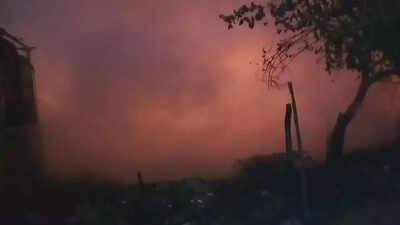Report on Recent Fire Incidents and Their Implications for Sustainable Development Goals
Incident Analysis: Rani Garden, Geeta Colony, Delhi
- Event: A major fire occurred in the Rani Garden slum area.
- Date and Time: The incident was reported at 1:05 AM on Thursday.
- Origin: The blaze reportedly started in a scrap warehouse located within the settlement.
- Impact: Approximately 15 to 20 slum dwellings were affected by the fire.
- Response: Eight fire department units were dispatched to the site to control the situation.
- Status: No casualties have been reported. The cause of the fire is currently under investigation.
Sustainable Development Goal (SDG) Implications of the Rani Garden Fire
- SDG 11: Sustainable Cities and Communities: This incident highlights critical challenges to achieving Target 11.1, which aims to ensure access for all to adequate, safe, and affordable housing. The fire exposes the extreme vulnerability of residents in informal settlements and underscores the urgent need for improved urban planning and disaster risk reduction strategies (Target 11.5) in densely populated areas.
- SDG 1: No Poverty: The destruction of homes and possessions directly undermines efforts to eradicate poverty. For the affected families, this event represents a catastrophic loss of assets, deepening their economic hardship and insecurity.
- SDG 3: Good Health and Well-being: The fire poses immediate risks to physical health from burns and smoke inhalation. The subsequent loss of shelter and security creates significant long-term stress and mental health challenges for displaced residents, compromising their overall well-being.
Incident Analysis: Shakti Khand 2, Indirapuram, Ghaziabad
- Event: A fire broke out in a formal residential apartment building.
- Date and Time: The incident was reported at 8:30 PM on Tuesday.
- Origin: The fire originated in a temporary structure on a flat’s balcony.
- Response: Seven fire tenders were dispatched and successfully controlled the blaze within 45 minutes.
- Status: The fire was extinguished with no reported injuries.
Sustainable Development Goal (SDG) Implications of the Ghaziabad Fire
- SDG 11: Sustainable Cities and Communities: This incident relates to urban safety and resilience. The rapid and effective response demonstrates a functioning emergency service, which is crucial for making cities safer. However, the fire’s origin points to potential issues with building codes and safety regulations that are central to sustainable urban development.
- SDG 16: Peace, Justice and Strong Institutions: The prompt and successful action by the fire department exemplifies the importance of effective and accountable institutions at the local level. A reliable emergency response system is a cornerstone of a well-governed, safe community, contributing directly to the goals of SDG 16.
Analysis of Sustainable Development Goals (SDGs) in the Article
1. Which SDGs are addressed or connected to the issues highlighted in the article?
-
SDG 11: Sustainable Cities and Communities
- The article discusses two fire incidents in urban settings: the slums of Rani Garden in Delhi and a residential building in Ghaziabad. These events directly relate to the safety and resilience of human settlements. The focus on a fire in a slum area specifically highlights the challenges of ensuring safety and adequate living conditions for vulnerable urban populations.
-
SDG 3: Good Health and Well-being
- Fires in residential areas pose a direct threat to the lives and health of residents, from potential casualties and injuries to the health impacts of smoke inhalation and the psychological stress of such events. The article’s repeated mention that there were no casualties or injuries directly connects the incidents to health outcomes and the effectiveness of emergency response in preserving well-being.
2. What specific targets under those SDGs can be identified based on the article’s content?
-
Target 11.1: By 2030, ensure access for all to adequate, safe and affordable housing and basic services and upgrade slums.
- The fire in the “slums of Rani Garden” affecting “15–20 slums” directly points to this target. The incident underscores the vulnerability of slum housing to disasters like fires, highlighting the lack of safe and adequate living conditions for its residents.
-
Target 11.5: By 2030, significantly reduce the number of deaths and the number of people affected and substantially decrease the direct economic losses relative to global gross domestic product caused by disasters… with a focus on protecting the poor and people in vulnerable situations.
- The fires described are localized disasters. The article’s emphasis on the outcome for residents (“no information about any casualties,” “No injuries have been reported”) aligns with the goal of reducing the human cost of disasters. The incident in the slums specifically relates to the target’s focus on protecting “people in vulnerable situations.”
-
Target 3.d: Strengthen the capacity of all countries… for early warning, risk reduction and management of national and global health risks.
- A fire in a densely populated area is a significant health risk. The article details the emergency response system in action (“A call was received,” “deployment of eight fire trucks,” “firefighters… arrived promptly”). This demonstrates the operational capacity for risk management and emergency response, which is crucial for mitigating health impacts from such events.
3. Are there any indicators mentioned or implied in the article that can be used to measure progress towards the identified targets?
-
Indicator 11.5.1: Number of deaths, missing persons and directly affected persons attributed to disasters per 100,000 population.
- The article provides direct data points for this indicator by stating, “There is no information about any casualties” and “No injuries have been reported.” This shows a successful outcome in minimizing the human impact of these specific disasters, which is what this indicator measures.
-
Indicator related to Target 11.1 (e.g., Proportion of urban population living in inadequate housing).
- While the article does not provide a statistical proportion, it implicitly points to this indicator by identifying the location as “the slums of Rani Garden” and noting that “The affected area has around 15–20 slums.” The fire itself serves as a qualitative indicator of the unsafe and inadequate nature of this housing.
-
Indicator 3.d.1: International Health Regulations (IHR) capacity and health emergency preparedness.
- The article implies a measure of this indicator by describing the effectiveness of the emergency response. Phrases like “deployment of eight fire trucks,” “arrived promptly,” and bringing the fire “under control within 45 minutes” serve as anecdotal evidence of a functioning and capable emergency preparedness system designed to manage health risks.
Summary Table of SDGs, Targets, and Indicators
| SDGs | Targets | Indicators |
|---|---|---|
| SDG 11: Sustainable Cities and Communities | 11.1: Ensure access for all to adequate, safe and affordable housing and basic services and upgrade slums. | Implied Indicator: The existence and vulnerability of slums to fire (“fire in the slums of Rani Garden”) serves as a qualitative indicator of inadequate and unsafe housing conditions. |
| SDG 11: Sustainable Cities and Communities | 11.5: Significantly reduce the number of deaths and people affected by disasters, with a focus on vulnerable people. | Indicator 11.5.1: Number of deaths and directly affected persons attributed to disasters. The article explicitly states “no information about any casualties” and “No injuries have been reported.” |
| SDG 3: Good Health and Well-being | 3.d: Strengthen the capacity for early warning, risk reduction and management of health risks. | Indicator 3.d.1: Health emergency preparedness. The article implies this through the description of a prompt and effective emergency response (“deployment of eight fire trucks,” “fire was extinguished in 45 minutes”). |
Source: timesofindia.indiatimes.com





